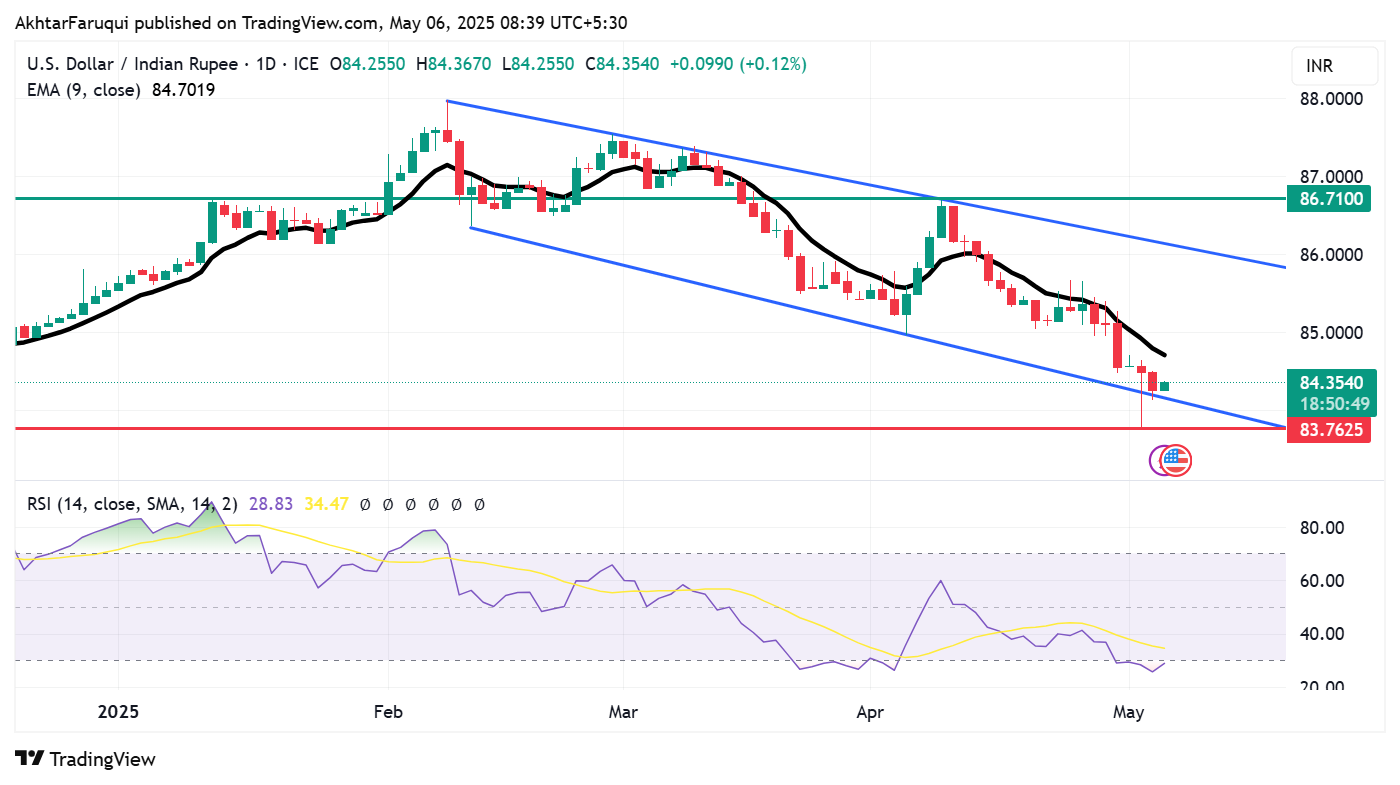USD/INR appreciates as traders adopt caution ahead of Fed policy
- Indian Rupee may regain its ground due to expected progress on a US-India trade agreement.
- USD/INR’s downside could be restrained due to importer hedging demand and potential RBI dollar-buying interventions.
- The INR may struggle due to improved crude oil prices, driven by OPEC+’s decision to ramp up production more quickly.
The Indian Rupee (INR) edges lower against the US Dollar (USD) during the Asian hours on Tuesday. However, the USD/INR pair may continue to encounter resistance as the INR gains support from certain market factors. Investors are closely watching the Federal Reserve’s policy decision, along with any progress on a US-India trade agreement and ongoing cross-border tensions.
The Indian Rupee drew support from strong equity inflows amounting to ₹2,769.81 crore. Furthermore, the recent launch of a new 10-year government bond with a 6.33% coupon saw solid demand and met market expectations. This favorable response may encourage additional foreign investment, further strengthening the Rupee.
The downside for the USD/INR pair may be capped by importer hedging demand and potential dollar-buying interventions by the Reserve Bank of India (RBI). The central bank is expected to continue bolstering its foreign exchange reserves, which have risen for the eighth straight week, reaching a more than six-month high of $688 billion as of April 25.
Additionally, the continued recovery in crude Oil prices puts downward pressure on the INR as India is the world's third-largest Oil consumer. However, Oil gains were capped by concerns over rising global supply following an OPEC+ decision to accelerate output increases. Last week, OPEC+, the Organization of the Petroleum Exporting Countries and its allies, agreed to ramp up production for a second straight month, announcing an additional 411,000 barrels per day (bpd) increase for June.
Indian Rupee advances as US Dollar appreciates ahead of Fed policy decision
- The US Dollar Index (DXY), which measures the US Dollar (USD) against a basket of six major currencies, is rebounding after two consecutive sessions of losses, trading near 99.80 at the time of writing.
- The US Dollar is strengthening ahead of the Federal Reserve’s (Fed) monetary policy announcement on Wednesday. While the Fed is widely expected to keep interest rates unchanged, markets are closely watching Chair Jerome Powell’s comments, particularly amid tariff-related uncertainty and mounting pressure from President Donald Trump for rate cuts.
- On the trade front, Treasury Secretary Scott Bessent stated Monday that the US is “very close to some deals,” echoing Trump’s weekend remarks suggesting progress in trade negotiations. However, Trump ruled out a meeting with Chinese President Xi Jinping this week. China’s Commerce Ministry said on Friday it is reviewing a US proposal to resume talks.
- US economic data showed strength in the services sector: the ISM Services PMI rose to 51.6 in April, beating forecasts of 50.6 and up from 50.8 in March. The New Orders Index increased to 52.3 from 50.4, while the Services Employment Index rose to 49 from 46.2.
- Traders anticipate India’s 10-year government bond yield to remain in the 6.30%–6.40% range this week, with attention centered on bond purchases and geopolitical developments between India and Pakistan.
- The recent decline in yields is driven by expectations of further rate cuts and the Reserve Bank of India (RBI) maintaining surplus liquidity in the banking system through ongoing open market operations (OMOs), according to Reuters.
- This week, the RBI plans to purchase bonds worth ₹750 billion ($8.88 billion), with two additional rounds of ₹250 billion each scheduled later this month. Year-to-date, the central bank has acquired ₹3.65 trillion in bonds via OMOs and ₹388 billion through secondary market purchases. This unexpected liquidity injection is likely to aid policy transmission and boost growth amid global uncertainties, said Radhika Rao, executive director and senior economist at DBS Bank.
- Escalating tensions between India and Pakistan could weigh on the Indian Rupee. On Saturday, Pakistan’s military announced it had carried out a training launch of a surface-to-surface missile with a 450-kilometer range. Meanwhile, New Delhi has accused Islamabad of supporting a recent attack on tourists in Kashmir.
USD/INR may retest descending channel’s lower boundary near 84.00
The Indian Rupee remains steady, with the USD/INR pair trading near 84.20 on Tuesday. Technical analysis of the daily chart indicates a continued bearish bias, as the pair trends lower within a descending channel pattern.
On the downside, the USD/INR pair may test support near the lower boundary of the descending channel around 84.10. A decisive break below this level could deepen the bearish momentum, potentially driving the pair toward the eight-month low of 83.76.
To the upside, initial resistance lies at the nine-day Exponential Moving Average (EMA) near 84.70. A breakout above this level could strengthen short-term bullish momentum, opening the path toward the channel’s upper boundary near 86.20, with further resistance at the two-month high of 86.71.
USD/INR: Daily Chart

Indian Rupee FAQs
The Indian Rupee (INR) is one of the most sensitive currencies to external factors. The price of Crude Oil (the country is highly dependent on imported Oil), the value of the US Dollar – most trade is conducted in USD – and the level of foreign investment, are all influential. Direct intervention by the Reserve Bank of India (RBI) in FX markets to keep the exchange rate stable, as well as the level of interest rates set by the RBI, are further major influencing factors on the Rupee.
The Reserve Bank of India (RBI) actively intervenes in forex markets to maintain a stable exchange rate, to help facilitate trade. In addition, the RBI tries to maintain the inflation rate at its 4% target by adjusting interest rates. Higher interest rates usually strengthen the Rupee. This is due to the role of the ‘carry trade’ in which investors borrow in countries with lower interest rates so as to place their money in countries’ offering relatively higher interest rates and profit from the difference.
Macroeconomic factors that influence the value of the Rupee include inflation, interest rates, the economic growth rate (GDP), the balance of trade, and inflows from foreign investment. A higher growth rate can lead to more overseas investment, pushing up demand for the Rupee. A less negative balance of trade will eventually lead to a stronger Rupee. Higher interest rates, especially real rates (interest rates less inflation) are also positive for the Rupee. A risk-on environment can lead to greater inflows of Foreign Direct and Indirect Investment (FDI and FII), which also benefit the Rupee.
Higher inflation, particularly, if it is comparatively higher than India’s peers, is generally negative for the currency as it reflects devaluation through oversupply. Inflation also increases the cost of exports, leading to more Rupees being sold to purchase foreign imports, which is Rupee-negative. At the same time, higher inflation usually leads to the Reserve Bank of India (RBI) raising interest rates and this can be positive for the Rupee, due to increased demand from international investors. The opposite effect is true of lower inflation.



